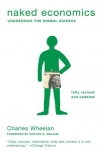Naked Economics Wheelan, Charles (books to read for 13 year olds TXT) 📖

Book online «Naked Economics Wheelan, Charles (books to read for 13 year olds TXT) 📖». Author Wheelan, Charles
Not all is rosy along the way, of course. Suppose one of our newly educated farmers designs a plow that produces even better yields, putting the first plow salesman out of business—creative destruction. True, this technological breakthrough eliminates one job in the short run. In the long run, though, the town is still better off. Remember, all the farmers are now richer (as measured by higher corn yields), enabling them to hire the unemployed agronomist to do something else, such as develop new hybrid seeds (which will make the town richer yet). Technology displaces workers in the short run but does not lead to mass unemployment in the long run. Rather, we become richer, which creates demand for new jobs elsewhere in the economy. Of course, educated workers fare much better than uneducated workers in this process. They are more versatile in a fast-changing economy, making them more likely to be left standing after a bout of creative destruction.
Human capital is about much more than earning more money. It makes us better parents, more informed voters, more appreciative of art and culture, more able to enjoy the fruits of life. It can make us healthier because we eat better and exercise more. (Meanwhile, good health is an important component of human capital.) Educated parents are more likely to put their children in car seats and teach them about colors and letters before they begin school. In the developing world, the impact of human capital can be even more profound. Economists have found that a year of additional schooling for a woman in a low-income country is associated with a 5 to 10 percent reduction in her child’s likelihood of dying in the first five years of life.5
Similarly, our total stock of human capital—everything we know as a people—defines how well off we are as a society. We benefit from the fact that we know how to prevent polio or make stainless steel—even if virtually no one reading this book would be able to do either of those things if left stranded on a deserted island. Economist Gary Becker, who was awarded the Nobel Prize for his work in the field of human capital, reckons that the stock of education, training, skills, and even the health of people constitutes about 75 percent of the wealth of a modern economy. Not diamonds, buildings, oil, or fancy purses—but things that we carry around in our heads. “We should really call our economy a ‘human capitalist economy,’ for that is what it mainly is,” Mr. Becker said in a speech. “While all forms of capital—physical capital, such as machinery and plants, financial capital, and human capital—are important, human capital is the most important. Indeed, in a modern economy, human capital is by far the most important form of capital in creating wealth and growth.”6
There is a striking correlation between a country’s level of human capital and its economic well-being. At the same time, there is a striking lack of correlation between natural resources and standard of living. Countries like Japan and Switzerland are among the richest in the world despite having relatively poor endowments of natural resources. Countries like Nigeria are just the opposite; enormous oil wealth has done relatively little for the nation’s standard of living. In some cases, the mineral wealth of Africa has financed bloody civil wars that would have otherwise died out. In the Middle East, Saudi Arabia has most of the oil while Israel, with no natural resources to speak of, has a higher per capita income.
High levels of human capital create a virtuous cycle; well-educated parents invest heavily in the human capital of their children. Low levels of human capital have just the opposite effect. Disadvantaged parents beget disadvantaged children, as any public school teacher will tell you. Mr. Becker points out, “Even small differences among children in the preparation provided by their families are frequently multiplied over time into large differences when they are teenagers. This is why the labor market cannot do much for school dropouts who can hardly read and never developed good work habits, and why it is so difficult to devise policies to help these groups.”7
Why does human capital matter so much? To begin with, human capital is inextricably linked to one of the most important ideas in economics: productivity. Productivity is the efficiency with which we convert inputs into outputs. In other words, how good are we at making things? Does it take 2,000 hours for a Detroit autoworker to make a car or 210 hours? Can an Iowa corn farmer grow thirty bushels of corn on an acre of land or 210 bushels? The more productive we are, the richer we are. The reason is simple: The day will always be twenty-four hours long; the more we produce in those twenty-four hours the more we consume, either directly or by trading it away for other stuff. Productivity is determined in part by natural resources—it is easier to grow wheat in Kansas than it is in Vermont—but in a modern economy, productivity is more affected by technology, specialization, and skills, all of which are a function of human capital.
America is rich because Americans are productive. We are better off today than at any other point in the history of civilization because we are better at producing goods and services than we have ever been, including things like health care and entertainment. The bottom line is that we work less and produce more. In 1870, the typical household required 1,800 hours of labor just to acquire its annual food supply; today, it takes about 260 hours of work. Over





Comments (0)